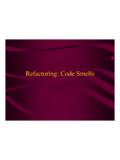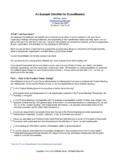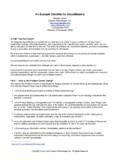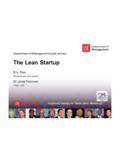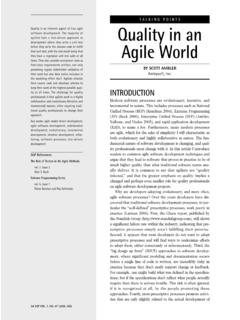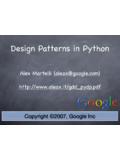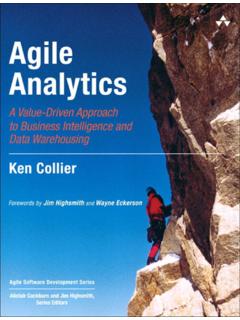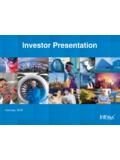Transcription of Working Effectively with Legacy Code - pearsoncmg.com
1 Working Effectively with Legacy CodeRobert C. Martin SeriesThis series is directed at software developers, team-leaders,business analysts, and managers who want to increase theirskills and proficiency to the level of a Master series contains books that guide software professionalsin the principles, patterns, and practices of programming,software project management, requirements gathering,design, analysis, testing, and Effectively with Legacy CodeMichael C. FeathersPrentice Hall Professional Technical ReferenceUpper Saddle River, NJ 07458www, authors and publisher have taken care in the preparation of this book, butmake no expressed or implied warranty of any kind and assume no responsibil-ity for errors or omissions. No liability is assumed for incidental or consequen-tial damages in connection with or arising out of the use of the information orprograms contained : John WaitEditor in Chief: Don O HaganAcquisitions Editor: Paul PetraliaEditorial Assistant: Michelle VincentiMarketing Manager: Chris GuzikowskiPublicist: Kerry GuilianoCover Designer: Sandra SchroederManaging Editor: Gina KanouseSenior Project Editor: Lori LyonsCopy Editor: Krista HansingIndexer: Lisa StumpfCompositor: Karen KennedyProofreader: Debbie WilliamsManufacturing Buyer: Dan Uhrig Prentice Hall offers excellent discounts on this book when ordered in quantity for bulkpurchases or special sales, which may include electronic versions and/or custom coversand content particular to your business, training goals, marketing focus, and branding in-terests.
2 For more information, please contact:U. S. Corporate and Government sales outside the U. S., please contact:International us on the web: of Congress Cataloging-in-Publication Data: 2004108115 Copyright 2005 Pearson Education, as Prentice Hall PTRAll rights reserved. Printed in the United States of America. This publication is protectedby copyright, and permission must be obtained from the publisher prior to any prohibitedreproduction, storage in a retrieval system, or transmission in any form or by any means,electronic, mechanical, photocopying, recording, or likewise. For information regardingpermissions, write to:Pearson Education, and Contracts DepartmentOne Lake StreetUpper Saddle River, NJ 07458 Other product or company names mentioned herein are the trademarks or registered trademarks of their respective 0-13-117705-2 Text printed in the United States on recycled paper at Phoenix Book printing, September 2004 For Ann, Deborah, and Ryan, the bright centers of my life.
3 MichaelThis page intentionally left blank CONTENTSviiContentsForeword by Robert C. Martin.. xvPreface .. xvIntroduction.. xxiPART I: The Mechanics of Change.. 1 Chapter 1: Changing Software .. 3 Four Reasons to Change Software .. 4 Risky Change .. 7 Chapter 2: Working with Feedback .. 9 What Is Unit Testing? .. 12 Higher-Level Testing .. 14 Test Coverings .. 14 The Legacy code Change Algorithm .. 18 Chapter 3: Sensing and Separation.. 21 Faking Collaborators .. 23 Chapter 4: The Seam Model.. 29A Huge Sheet of Text .. 29 Seams .. 30 Seam Types .. 33 Chapter 5: Tools.. 45 Automated Refactoring Tools .. 45 Mock Objects .. 47 Unit-Testing Harnesses .. 48 General Test Harnesses .. 53viiiCONTENTSPART II: Changing Software .. 55 Chapter 6: I Don t Have Much Time and I Have to Change It.. 57 Sprout Method.
4 59 Sprout Class .. 63 Wrap Method .. 67 Wrap Class .. 71 Summary.. 76 Chapter 7: It Takes Forever to Make a Change .. 77 Understanding .. 77 Lag Time .. 78 Breaking Dependencies .. 79 Summary .. 85 Chapter 8: How Do I Add a Feature? .. 87 Test-Driven Development (TDD) .. 88 Programming by Difference .. 94 Summary .. 104 Chapter 9: I Can t Get This Class into a Test Harness.. 105 The Case of the Irritating Parameter .. 106 The Case of the Hidden Dependency .. 113 The Case of the Construction Blob .. 116 The Case of the Irritating Global Dependency .. 118 The Case of the Horrible Include Dependencies .. 127 The Case of the Onion Parameter .. 130 The Case of the Aliased Parameter .. 133 Chapter 10: I Can t Run This Method in a Test Harness.. 137 The Case of the Hidden Method .. 138 The Case of the Helpful Language Feature.
5 141 The Case of the Undetectable Side Effect .. 144 Chapter 11: I Need to Make a Change. What Methods Should I Test? .. 151 Reasoning About Effects .. 151 Reasoning Forward .. 157 Effect Propagation .. 163 Tools for Effect Reasoning .. 165 Learning from Effect Analysis .. 167 Simplifying Effect Sketches .. 168 CONTENTSixChapter 12: I Need to Make Many Changes in One .. 173 Interception Points .. 174 Judging Design with Pinch Points .. 182 Pinch Point Traps .. 184 Chapter 13: I Need to Make a Change, but I Don t Know What Tests to Write .. 185 Characterization Tests .. 186 Characterizing Classes .. 189 Targeted Testing .. 190A Heuristic for Writing Characterization Tests .. 195 Chapter 14: Dependencies on Libraries Are Killing Me .. 197 Chapter 15: My Application Is All API Calls .. 199 Chapter 16: I Don t Understand the code Well Enough to Change It.
6 209 Notes/Sketching .. 210 Listing Markup .. 211 Scratch Refactoring .. 212 Delete Unused code .. 213 Chapter 17: My Application Has No Structure .. 215 Telling the Story of the System .. 216 Naked CRC .. 220 Conversation Scrutiny .. 224 Chapter 18: My Test code Is in the Way .. 227 Class Naming Conventions .. 227 Test Location .. 228 Chapter 19: My Project Is Not Object Oriented. How Do I Make Safe Changes?.. 231An Easy Case .. 232A Hard Case .. 232 Adding New Behavior .. 236 Taking Advantage of Object Orientation .. 239It s All Object Oriented .. 242 Chapter 20: This Class Is Too Big and I Don t Want It to Get Any Bigger . 245 Seeing Responsibilities .. 249xCONTENTSO ther Techniques .. 265 Moving Forward .. 265 After Extract Class .. 268 Chapter 21: I m Changing the Same code All Over the Place.
7 269 First Steps .. 272 Chapter 22: I Need to Change a Monster Method and I Can t Write Tests for It .. 289 Varieties of Monsters .. 290 Tackling Monsters with Automated Refactoring Support .. 294 The Manual Refactoring Challenge .. 297 Strategy .. 304 Chapter 23: How Do I Know That I m Not Breaking Anything?.. 309 Hyperaware Editing .. 310 Single-Goal Editing .. 311 Preserve Signatures .. 312 Lean on the Compiler .. 315 Chapter 24: We Feel Overwhelmed. It Isn t Going to Get Any Better.. 319 PART III: Dependency-Breaking Techniques .. 323 Chapter 25: Dependency-Breaking Techniques .. 325 Adapt Parameter .. 326 Break Out Method Object .. 330 Definition Completion .. 337 Encapsulate Global References .. 339 Expose Static Method .. 345 Extract and Override Call .. 348 Extract and Override Factory Method .. 350 Extract and Override Getter.
8 352 Extract Implementer .. 356 Extract Interface .. 362 Introduce Instance Delegator .. 369 Introduce Static Setter .. 372 Link Substitution .. 377 Parameterize Constructor .. 379 Parameterize Method .. 383 CONTENTSxiPrimitivize Parameter .. 385 Pull Up Feature .. 388 Push Down Dependency .. 392 Replace Function with Function Pointer .. 396 Replace Global Reference with Getter .. 399 Subclass and Override Method .. 401 Supersede Instance Variable .. 404 Template Redefinition .. 408 Text Redefinition .. 412 Appendix: Refactoring .. 415 Extract Method .. 415 Glossary.. 421 Index .. 423 This page intentionally left blank FOREWORD xiiiForeword ..then it In his introduction to this book, Michael Feathers uses that phrase todescribe the start of his passion for software..then it Do you know that feeling?
9 Can you point to a single moment in your life andsay: ..then it ? Was there a single event that changed the course ofyour life and eventually led you to pick up this book and start reading this fore-word?I was in sixth grade when it happened to me. I was interested in science andspace and all things technical. My mother found a plastic computer in a catalogand ordered it for me. It was called Digi-Comp I. Forty years later that littleplastic computer holds a place of honor on my bookshelf. It was the catalystthat sparked my enduring passion for software. It gave me my first inkling ofhow joyful it is to write programs that solve problems for people. It was justthree plastic S-R flip-flops and six plastic and-gates, but it was enough itserved. for it the joy I felt soon became tempered by the realization that software sys-tems almost always degrade into a mess.
10 What starts as a clean crystallinedesign in the minds of the programmers rots, over time, like a piece of badmeat. The nice little system we built last year turns into a horrible morass oftangled functions and variables next does this happen? Why do systems rot? Why can t they stay clean?Sometimes we blame our customers. Sometimes we accuse them of changingthe requirements. We comfort ourselves with the belief that if the customers hadjust been happy with what they said they needed, the design would have beenfine. It s the customer s fault for changing the requirements on , here s a news flash: Requirements change. Designs that cannot toleratechanging requirements are poor designs to begin with . It is the goal of everycompetent software developer to create designs that tolerate seems to be an intractably hard problem to solve.










